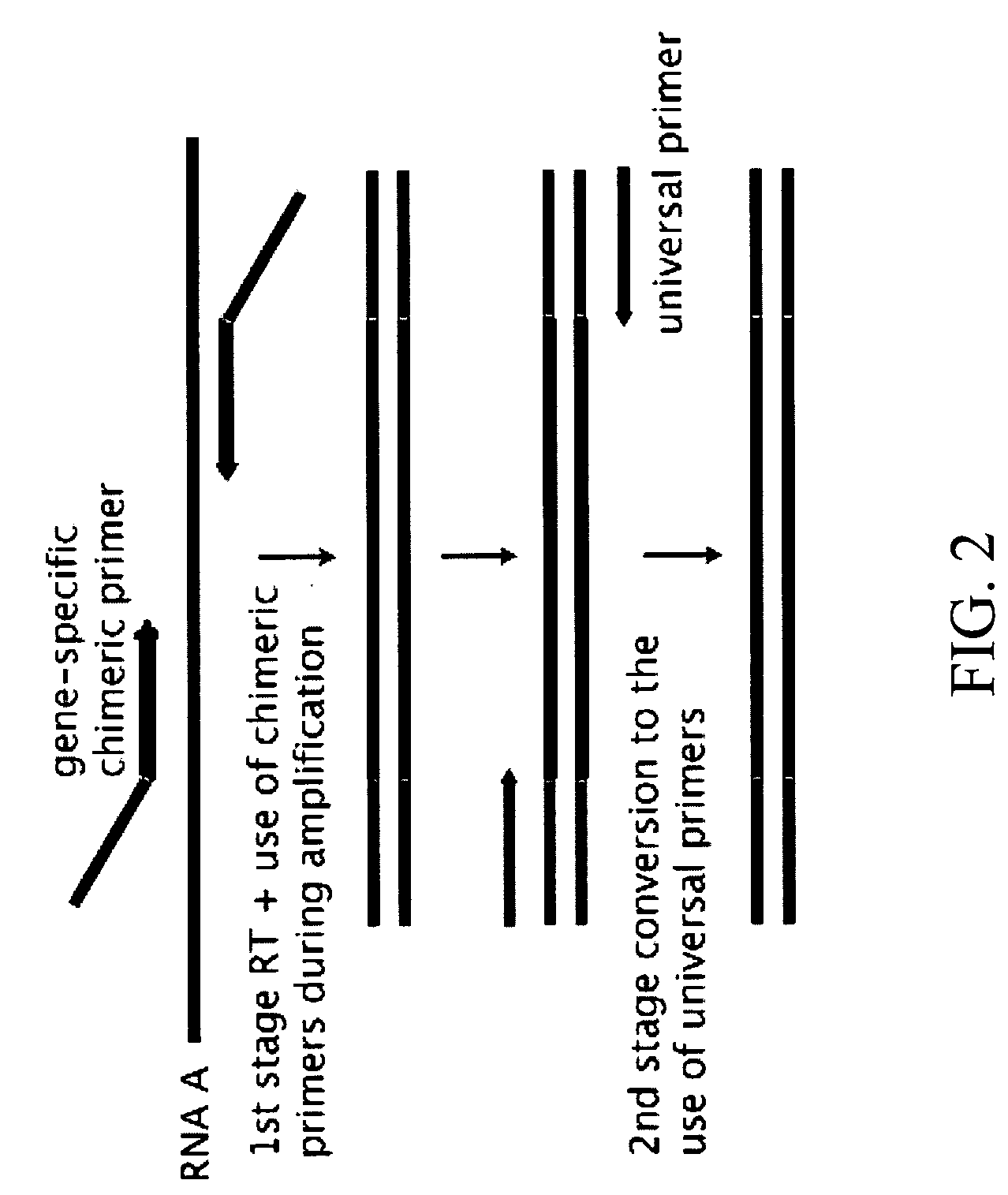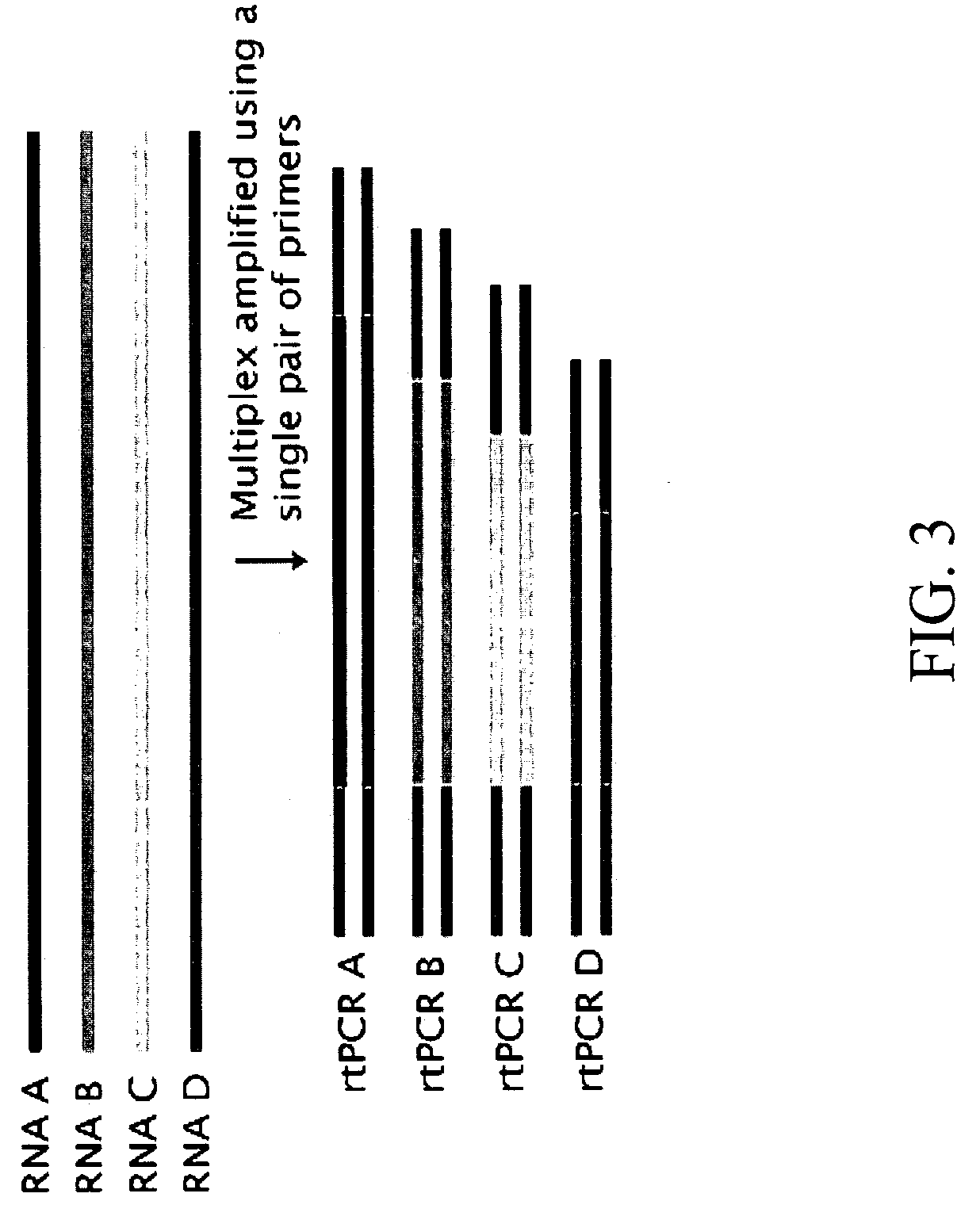Compositions and methods for the analysis of degraded nucleic acids
a nucleic acid and degraded technology, applied in the field of gene expression analysis, can solve the problems of rna quality, high susceptibility of rna samples isolated from tissues, and degraded rna contained in specimens, and achieve the effects of facilitating detection or quantification, facilitating fabrication, and facilitating handling, placement, and stacking
- Summary
- Abstract
- Description
- Claims
- Application Information
AI Technical Summary
Benefits of technology
Problems solved by technology
Method used
Image
Examples
example 1
Toxicology Multiplex UPM-PCR Assay
[0219] The present Example describes a multiplex UPM-PCR using a 24-gene panel focused on a number of classical toxicological response endpoints following pharmaceutical treatment of cultured cells.
[0220] These gene expression endpoints used in the analysis include a number of different inducible cytochromes, as well as genes that report on oxidative stress, DNA damage, cell proliferation, apoptosis and a number of other important toxicology-related pathways. The gene set used in the toxicology panel are listed in Table 3.
TABLE 3Toxicology Gene PanelGeneGenBank Accession No.Ro-CYP1A1NM_012540Ro-CYP4A1M57718Ro-CYP2B1U30327Ro-CYP3A1L24207Ro-CYP2E1NM_031543Ro-HO1J02722TSC22L25785NADPH CYPM12516UGTB1XM_214015Ro-aldDHAE001898RoNQONM_017000Ro-ApoA-IVM00002Ro-p21U24174p53NM_030989Ro-gadd45L32591Ro-gadd153U36994Ro-COX-2S67722caspase-3NM_012922Ro-cyclinD1NM_171992Ro-PCNANM_022381Ro-CycloANM_017101Ro-betaActinNM_031144Ro-GAPDHNM_017008kanamycin (Kan)refer...
example 2
Tumor Tissue Multiplex UPM-PCR Assay
[0225] The present Example describes a multiplex UPM-PCR using a 33-gene panel that can differentiate four closely related tumor classes.
[0226] A study of multiplexed PCR assays for the differentiation and diagnosis of multiple forms of childhood cancer classified as small round blue-cell tumors (SRBCTs) was undertaken. SRBCTs represent four classes of tumor type: neuroblastoma, rhabdomyosarcoma, Burkitt's lymphoma and Ewing family tumors, that are important pediatric cancers. As the name eludes, SRBCTs are relatively difficult to differentiate in routine histology, but Khan et al., (“Classification and Diagnostic Prediction of Cancers Using Gene Expression Profiling and Artificial Neural Networks,”Nature 7:673-679 [2001]) found that significant differences can be seen in their gene expression patterns. In the 2001 study, a cDNA microarray with 6567 total genes was used to analyze 88 samples that included both tissues and cell lines for each of ...
example 3
Preparation of Test RNA Samples
[0227] Proper controls are a key feature in any scientific study. The present Example describes preparation of test control degraded RNA samples containing various degrees of RNA degradation for the purpose of developing and testing the methods of the invention. With these samples it is possible to directly compare the levels of gene expression and the impact of RNA degradation on these expression levels. This approach allows the synthetic creation of a broad range of degradation, as well as different types of mechanistic degradation, so that many levels and / or types of degradation can be studied.
[0228] Two types of human test RNAs are prepared, each in multiple ways to represent progressively greater levels of degradation. Type 1 is total RNAs derived from several different tissue types, including tissue mixes, that is degraded via chemical and enzymatic titrations. Type 2 is RNAs derived from fresh frozen and FFPE blocks all prepared from the same ...
PUM
| Property | Measurement | Unit |
|---|---|---|
| Electrical conductance | aaaaa | aaaaa |
| Electrical conductance | aaaaa | aaaaa |
| Time | aaaaa | aaaaa |
Abstract
Description
Claims
Application Information
 Login to View More
Login to View More - R&D
- Intellectual Property
- Life Sciences
- Materials
- Tech Scout
- Unparalleled Data Quality
- Higher Quality Content
- 60% Fewer Hallucinations
Browse by: Latest US Patents, China's latest patents, Technical Efficacy Thesaurus, Application Domain, Technology Topic, Popular Technical Reports.
© 2025 PatSnap. All rights reserved.Legal|Privacy policy|Modern Slavery Act Transparency Statement|Sitemap|About US| Contact US: help@patsnap.com



